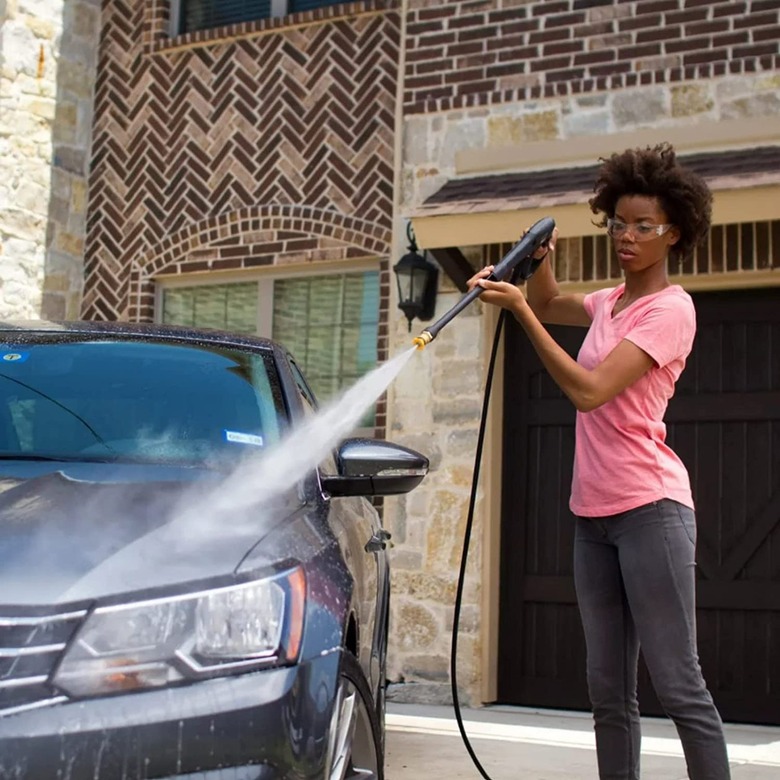How To Attach The Nozzles To A Karcher Electric Pressure Washer
We may receive a commission on purchases made from links.
Karcher electric pressure washers are made in Germany, and like all the best German brands, such as Bosch, BMW, and Siemens, they are well regarded and popular. A Karcher pressure washer is supplied with a high-pressure hose, a wand with a trigger, and several nozzles, also called tips by some pros.
The nozzles that come with a Karcher pressure washer include a 15-degree nozzle for concentrated cleaning power, a 40-degree nozzle for applying soap, and a turbo nozzle for heavy-duty cleaning. In addition, you can buy optional nozzles with different spray patterns for specific jobs. You install them all the same way.
Attaching the Hoses and Wand
Attaching the Hoses and Wand
Karcher supplies detailed instructions with its pressure washers, but in case you borrowed or inherited the one you're using, a little guidance may help. For safety, make all hose connections before you plug in the pressure washer.
- Screw a garden hose onto the 3/4-inch female port on the pressure washer and connect the garden hose to an outdoor spigot.
- Screw the end of the pressure hose with the female threaded fitting into the male port on the machine. You have to maintain fairly strong inward pressure on the fitting to get the threads to bite because it contains a spring-loaded compression washer to make a good pressure seal.
- Install the wand on the other end of the pressure hose by aligning the notches on the end of the wand with the grooves in the end of the hose and pushing the wand and hose together. When the notches are fully inserted, twist the wand 90 degrees to lock it in.
Installing and Removing Nozzles
Installing and Removing Nozzles
The other end of the wand has a quick-connect fitting with ball bearings that lock onto the contoured shafts of the nozzles. All pressure washer nozzles have the same type of shaft, and all can be used with a Karcher pressure washer. To install a nozzle, pull the quick-connect fitting down, insert the nozzle, and release the fitting.
When you want to remove a nozzle, the procedure is the same except you pull the nozzle out rather than pushing it in. If you have trouble inserting or removing a nozzle, it's probably because the pump is on and the hose is pressurized. You should be able to operate the quick-connect fitting even when the hose is pressurized, but if not, turn off the pump and press the trigger on the wand to release pressure.
Choosing a Pressure Washer Nozzle
Choosing a Pressure Washer Nozzle
Pressure washer nozzles are color-coded, and each has a specific purpose. When using a pressure washer, it's important to use the right one.
- Red; 0 degrees: The red nozzle is for extreme cleaning of concrete, metal, and other hard surfaces. It should never be used on wood, vinyl, or composites.
- Yellow; 15 degrees: The yellow nozzle is the one to use for deep cleaning siding, decking, and other wood surfaces.
- Green; 25 degrees: The green nozzle is also for cleaning. Use it on surfaces that could be damaged by high pressure.
- White, black, or blue; 40 or 65 degrees: Nozzles with wide spray patterns are soap nozzles. Use them when you add detergent to the reservoir.
- Turbo: The turbo nozzle is long and cylindrical and works somewhat like a rotary sprinkler. It emits a 0-degree spray pattern, but the internal gears keep the spray rotating in a circle, which makes it less destructive than the spray from the red tip. Most pressure washers come with a turbo nozzle, and you use it for deep cleaning.
